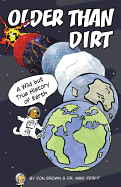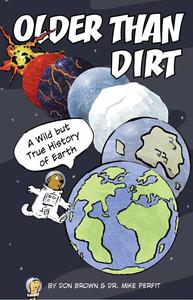
 From "a Big Bang" to the existence of humans, Sibert Honor medalist Don Brown (Drowned City; America Is Under Attack) and geologist Mike Perfit boil down more than 14 billion years of planetary evolution in Older Than Dirt, a delightful, informative and engrossing work of graphic nonfiction. Using a brainy groundhog to narrate, Brown and Perfit educate their readers--and the groundhog's worm friend--about the incredible stages of Earth's history.
From "a Big Bang" to the existence of humans, Sibert Honor medalist Don Brown (Drowned City; America Is Under Attack) and geologist Mike Perfit boil down more than 14 billion years of planetary evolution in Older Than Dirt, a delightful, informative and engrossing work of graphic nonfiction. Using a brainy groundhog to narrate, Brown and Perfit educate their readers--and the groundhog's worm friend--about the incredible stages of Earth's history.
In an effort to make billion- and million-year time spans accessible to young readers, the work uses a metaphorical 24-hour day, plotting the course of Earth's explosive beginning, through numerous transformations, to the age when humans came into existence. That the arrival of humans occurred at the very final minute of this "day" highlights our relatively new presence on Earth more forcefully than the concept of thousands of years. With a combination of humor and analogies ("Earth's crust cracked like the shell of a hard-boiled egg") that middle graders can relate to, the pair turn highly complex scientific evidence into fun, engaging and memorable content. For example, the groundhog explains the concept of density to her worm pal:
Groundhog: "Plutons float because they are less dense than the mantle."
Worm: "What's 'dense'?"
Groundhog: "Worms, apparently."
Worm: "No really."
Groundhog: "Density is the difference in weight between things the same size. Think of a bucket full of sand compared to the same sized bucket filled with marshmallows."
Interspersed throughout the groundhog and worm's conversation are "Deep Time Comix" sections. Each pair of sepia-color comic book pages presents historical figures who played important roles in discovering information shared by the groundhog: James Hutton, the father of geology; Alfred Wegener, whose fascination with weather led him to the theory of continental drift; and Bruce Heezen and Maire Tharp, the duo whose map of the ocean floor helped make plate tectonics accepted scientific theory.
Brown's powerful illustrations emphasize the extraordinary interactions of nature and the outcomes of those interactions: an image of thriving ocean life next to a sea of fish skeletons, a lush landscape juxtaposed with a scorched earth, a plate collision resulting in extensive mountain ranges. He relates elaborate movement, temperature and energy through basic color, stroke and texture. The small details added to his storytellers, like earmuffs, sunglasses and swimming flippers, inject ticklish humor that adds to their small, witty side comments:
Groundhog: "The restless tectonic plates carried continents here and there... at a few inches a year."
Worm: "Hey, I'm faster than that!"
A small diversion caused by gender confusion between the worm and the groundhog is whimsical and a gentle reminder about assumptions and preconceived notions.
Older Than Dirt is aimed at middle-grade readers but the entertaining illustrations and fascinating information will enthrall audiences of any age. Older readers will likely find learn something new, and it's an excellent book to read together with younger readers. Older Than Dirt's playful nature and innovative approach make learning science a true joy. --Jen Forbus, freelancer
Shelf Talker: In this fascinating work of graphic nonfiction, a groundhog, with the help of a worm, relates the entire scientific history of planet Earth, scaled to a 24-hour day.

